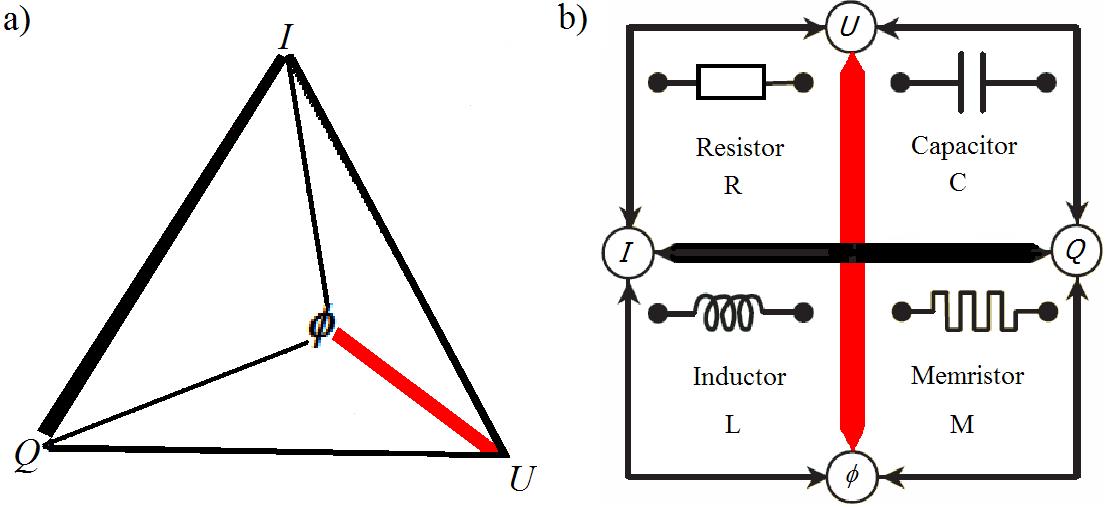The so called "memristor" is an intriguing case for the sociology of science [2] and it still unfolds. Especially annoying are critics who do not grasp the core issue. They hand easily refuted charges to Goliath so he can point to them laughing: “Look, all that criticism is mere envious pseudo-science”.
UPDATE: new article on that the memristor has not been found now published by Nature group
There may also be serious plagiarism involved, but let us focus on the core issue, which is independent of technicalities about ‘pinched loops’ or that the devices have been around since 1967 [3], even before the real memristor was predicted [4] in 1971!
That the 2008 claimed discovery is false can be easily understood [5]: The prediction of the fourth device is based on electro-magnetic symmetry. Without magnetism, there are 2, namely resistor (R) and capacitor (C). Magnetism seems to naively add 2 more, called inductor (L) and memristor (M). The inductor, a simple copper coil, of course exists. The memristor, just like magnetic charges (monopoles), probably not [5].
In case there is only electricity (no magnetism), we have only 2 (not 3): No memristor and no inductor either. As you see, this is not even about the memristor. It is about something everybody knows: Without magnetism, there is no inductor! The name inductor means precisely that: It induces magnetic fields and the related magnetically induced voltage.
The devices described in [1] work without any magnetism. There are ions that change the resistance of a thin film, much like you could attach a counter that looks at how much charge flows and adjusts the resistance accordingly via a knob. If we would accept such contraptions as the memristor, there would be 3 real devices (corresponding to basic circuit elements) without magnetism. Impossible!

The devices work just as well without magnetism.
The very argument [3] used to predict the memristor as a fourth device from our well known 3 (R, C, L), that very argument could now be used in a world without any magnetism to demand a fourth device, again from the existence of 3 [if there were such a thing as a memristor in such a world that could be added as a third element to the resistor and the capacitor (M, R, C)]. That fourth element would be the inductor L, something that induces magnetic fields in a world without magnetism!
It is ridiculous, yet because high profile people and money are involved, people defend the fake “discoverers” with desperate means. There is for example this archive paper (a lot of pseudoscience finds its way onto the archive). It claims that because there is magnetic flux due to the oxygen vacancies, the devices are memristors. This is equivalent to arguing that magnetism is vitally involved if there is a fridge magnet glued under the counter that turns a knob on an adjustable resistor, therefore such a contraption is a memristor (as long as the fridge magnet sticks).
We are talking about a fundamental symmetry of physics, as clear cut as energy conservation due to time-translation symmetry. There is no perpetual motion machine even if you use fridge magnets! Fundamental symmetries are not argued against with some engineering mindset drawing on strange old references about materials chemistry. The proposed real memristor device was crucially based on EM symmetry.
Here once more a picture illustrating the underlying symmetry that suggests the true memristor, which has never been found and may well be impossible:
Illustrations [5] of the symmetry that led to proposing the memristor: (a) the tetrahedron spanned by the four fundamental circuit variables (current I, voltage U, electrical charge Q, and flux phi), (b) the relations and circuit symbols of the four basic two-terminal circuit elements that correspond to the four thin edges in (a).
---------------
* The strength of magnetism depends on the velocity of light c, so if c were much larger, there would be no magnetism measurable; we would have never discovered it even though we could still discover the thin film devices falsely called “memristor”.
---------------
[1] D. B. Strukov et al.: “The missing memristor found.” Nature 453, 80-83 (2008)
[2] S. Vongehr: “The Missing Memristor: Novel Nanotechnology or rather new Case Study for the Philosophy and Sociology of Science?” http://arxiv.org/abs/1205.6129
[3] F. Argall: “Switching Phenomena in Titanium Oxide Thin Films” Solid-State Electronics Pergamon Press 11,535-541 (1968)
[4] L.O. Chua: “Memristor – the missing circuit element.” IEEE Trans. On Circuit Theory CT-18, 507-519 (1971)
[5] S. Vongehr “Missing the Memristor.” Adv Sci Lett 17, 285-290(2012)






Comments